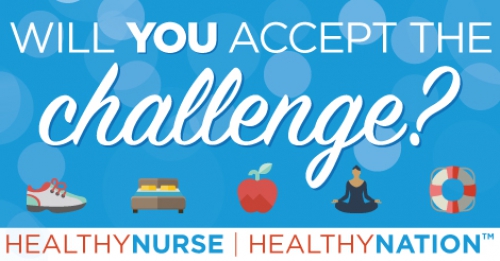Healthy Nurse, Healthy Nation™ Blog - Children Living With Obesity
Published
Authors: Elizabeth Coleman, MSN, CRNP, CPNP-PC, Nursing Instructor & Loretta T. Lee, PhD, CRNP, FNP-BC, CNE, Associate Professor and Department Vice Chair Family, Community & Health Systems at the UAB School of Nursing, University of Alabama at Birmingham
Ms. Coleman is pictured below.
 Obesity is prevalent in the United States (U.S) pediatric population. Hispanic and non-Hispanic African American children (ages 2-19) are more likely to be obese than their non-Hispanic white counterparts. According to the Centers for Disease Control and Prevention, obesity rates in 2019 were Hispanic (26%), non-Hispanic African American (22%), and 14. % for non-Hispanic white children (Centers for Disease Control and Prevention [CDC], 2019). Among under-resourced populations, many barriers exist that contribute to the disparity of obesity rates in children. For example, many under-resourced adolescents lack access to healthcare, live in food deserts, and have limited exercise options (Larson et al., 2009; Mangadu et al., 2017). Food deserts are regions lacking grocery stores offering healthy products such as produce (Mangadu et al., 2017). Poorly built environments often expose children to neighborhoods without sidewalks or parks. Hence these children cannot play and exercise safely in their communities. Although some non-Hispanic white children may experience these same barriers to healthy living, an abundance of evidence has shown that under-resourced populations are at greater risk of living in a food desert and poorly built environments with limited access to healthcare. Therefore, Hispanic and non-Hispanic black youths are at higher risk for obesity.
Obesity is prevalent in the United States (U.S) pediatric population. Hispanic and non-Hispanic African American children (ages 2-19) are more likely to be obese than their non-Hispanic white counterparts. According to the Centers for Disease Control and Prevention, obesity rates in 2019 were Hispanic (26%), non-Hispanic African American (22%), and 14. % for non-Hispanic white children (Centers for Disease Control and Prevention [CDC], 2019). Among under-resourced populations, many barriers exist that contribute to the disparity of obesity rates in children. For example, many under-resourced adolescents lack access to healthcare, live in food deserts, and have limited exercise options (Larson et al., 2009; Mangadu et al., 2017). Food deserts are regions lacking grocery stores offering healthy products such as produce (Mangadu et al., 2017). Poorly built environments often expose children to neighborhoods without sidewalks or parks. Hence these children cannot play and exercise safely in their communities. Although some non-Hispanic white children may experience these same barriers to healthy living, an abundance of evidence has shown that under-resourced populations are at greater risk of living in a food desert and poorly built environments with limited access to healthcare. Therefore, Hispanic and non-Hispanic black youths are at higher risk for obesity.Children living with obesity can suffer health complications later in life, such as hyperlipidemia, hypertension, and diabetes (Grossman et al., 2017). Obesity is also linked to mental health conditions in the adolescent population. Some researchers report a bidirectional relationship between obesity and mental health conditions (Chao et al., 2019). Chao and colleagues 2019 and Gow et al. (2019) have found associations between decreased self-esteem, obesity, and increased depressive symptoms in adolescents. Moreover, Eisenberg et al. (2019) found a correlation between teased adolescents living with obesity and lower self-esteem and depressive symptoms.
The associated co-morbidities, present and in the future of youths living with obesity, indicate a need to intervene with robust interventions to improve the quality of life among under-resourced children. An intervention for obesity is Cognitive Behavioral Therapy (CBT). Several studies using a CBT-based program improved healthy lifestyle behaviors and mental health conditions associated with obesity (Hoying et al., 2016; Melnyk, 2020; Melnyk et al., 2015). Melnyk et al. found a decrease in the proportion of overweight and obese and decreased depression symptoms in adolescents after implementing a CBT-based program (2015). These findings were supported by a systematic review of treatments for adolescents living with overweight and obesity (Militello et al., 2018). Reported studies in this systematic review revealed that components of CBT, such as cognitive restructuring, behavioral techniques, problem-solving, coping, and relaxation techniques were effective strategies for reducing mental health concerns among those living with obesity. Also, parental involvement has been reported to improve weight outcomes (Militello et al., 2018).
A significant concern among the adolescent population is stress-eating. A mindfulness-based intervention can help to prevent worsening stress-eating in adolescents with an increased risk for weight gain (Bernstein et al., 2021). A systematic review explored the benefits of mindfulness as an intervention for children and adolescents living with obesity. The authors report that studies included in the systematic review revealed that mindfulness or stress management helped to reduce obesity (Paltoglou et al., 2021). Hence, mindfulness can be essential in decreasing obesity in the adolescent population.
Improving access to healthy foods for children is essential in schools and the community. Equally important is targeted nutritional eating education for children and providing youths with engaging physical activity. Structural and societal influences that create racial disparities must be eliminated to provide safe spaces for all children to exercise outdoors and access convenient options for securing affordable and healthy foods — especially fresh fruits and vegetables.
Notwithstanding the effective therapies and strategies mentioned above, pharmacological treatment is often needed in conjunction with other interventions to manage obesity (Xu & Xue, 2016). Obesity is a chronic condition that affects many children and adolescents in the U.S, particularly those from minority and under-resourced populations. To improve the quality of life and decrease morbidity among under-resourced youths, obesity must be addressed with early interventions. These interventions should include proven effective interventions such as behavioral modification, pharmacological therapy, improved health education, and attention to poorly built environments found disproportionately in high-poverty areas.
References
Bernstein, R., Sanchez, N., Clark, E. L. M., Conte, I., Gulley, L. D., Legget, K. T., Cornier, M. A., Melby, C., Johnson, S. A., Lucas-Thompson, R., & Shomaker, L. B. (2021, Dec). Mindfulness-based intervention in adolescents at risk for excess weight gain: 1.5-year follow-up of pilot randomized controlled trial. Eat Behav, 43, 101580. https://doi.org/10.1016/j.eatbeh.2021.101580
Centers for Disease Control and Prevention. (2019). Childhood obesity facts. https://www.cdc.gov/obesity/data/childhood.html
Chao, A. M., Wadden, T. A., & Berkowitz, R. I. (2019, Jan 19). Obesity in adolescents with psychiatric disorders. Current Psychiatry Reports, 21(1), 3. https://doi.org/10.1007/s11920-019-0990-7
Eisenberg, M. E., Puhl, R., Areba, E. M., & Neumark-Sztainer, D. (2019, Jul). Family weight teasing, ethnicity and acculturation: Associations with well-being among latinx, hmong, and somali adolescents. Journal of Psychosomatic Research, 122, 88-93. https://doi.org/10.1016/j.jpsychores.2019.04.007
Gow, M. L., Tee, M. S. Y., Garnett, S. P., Baur, L. A., Aldwell, K., Thomas, S., Lister, N. B., Paxton, S. J., & Jebeile, H. (2020, Mar). Pediatric obesity treatment, self-esteem, and body image: A systematic review with meta-analysis. Pediatric Obesity, 15(3), e12600. https://doi.org/10.1111/ijpo.12600
Grossman, D. C., Bibbins-Domingo, K., Curry, S. J., Barry, M. J., Davidson, K. W., Doubeni, C. A., Epling, J. W., Jr., Kemper, A. R., Krist, A. H., Kurth, A. E., Landefeld, C. S., Mangione, C. M., Phipps, M. G., Silverstein, M., Simon, M. A., & Tseng, C.-W. (2017). Screening for obesity in children and adolescents: Us preventive services task force recommendation statement. JAMA: Journal of the American Medical Association, 317(23), 2417-2426. https://doi.org/10.1001/jama.2017.6803
Hoying, J., Melnyk, B. M., & Arcoleo, K. (2016, Jan-Feb). Effects of the cope cognitive behavioral skills building teen program on the healthy lifestyle behaviors and mental health of appalachian early adolescents. Journal of Pediatric Health Care, 30(1), 65-72. https://doi.org/10.1016/j.pedhc.2015.02.005
Larson, N. I., Story, M. T., & Nelson, M. C. (2009). Neighborhood environments: Disparities in access to healthy foods in the U.S. American Journal of Preventive Medicine, 36(1), 74-81. https://doi.org/10.1016/j.amepre.2008.09.025
Mangadu, T., Kelly, M., Orezzoli, M. C. E., Gallegos, R., & Matharasi, P. (2017, Dec 1). Best practices for community gardening in a US-Mexico border community. Health Promotion International, 32(6), 1001-1014. https://doi.org/10.1093/heapro/daw025
Melnyk, B. M. (2020, Mar - Apr). Reducing healthcare costs for mental health hospitalizations with the evidence-based cope program for child and adolescent depression and anxiety: A cost analysis. Journal of Pediatric Health Care, 34(2), 117-121. https://doi.org/10.1016/j.pedhc.2019.08.002
Melnyk, B. M., Jacobson, D., Kelly, S. A., Belyea, M. J., Shaibi, G. Q., Small, L., O'Haver, J. A., & Marsiglia, F. F. (2015, Dec). Twelve-month effects of the cope healthy lifestyles teen program on overweight and depressive symptoms in high school adolescents. Journal of School Health, 85(12), 861-870. https://doi.org/10.1111/josh.12342
Militello, L. K., Kelly, S., Melnyk, B. M., Smith, L., & Petosa, R. (2018, Dec). A review of systematic reviews targeting the prevention and treatment of overweight and obesity in adolescent populations. Journal of Adolescent Health, 63(6), 675-687. https://doi.org/10.1016/j.jadohealth.2018.07.013
Paltoglou, G., Chrousos, G. P., & Bacopoulou, F. (2021, Jul 31). Stress management as an effective complementary therapeutic strategy for weight loss in children and adolescents with obesity: A systematic review of randomized controlled trials. Children (Basel), 8(8). https://doi.org/10.3390/children8080670
Xu, S., & Xue, Y. (2016, Jan). Pediatric obesity: Causes, symptoms, prevention and treatment. Experimental and Therapeutic Medicine, 11(1), 15-20. https://doi.org/10.3892/etm.2015.2853

Not a member of Healthy Nurse, Healthy Nation (HNHN) yet? Join today!
Join our monthly challenges at hnhn.org/challenges.
Blog Nutrition
10/31/2022 9:32am CDT



Post a Comment or Question